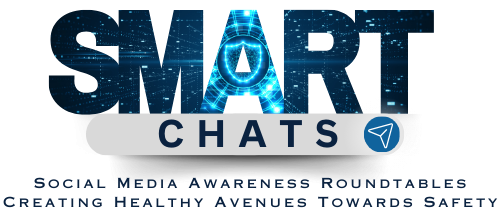Internet Safety: Tips for Parents and Kids, and Protection Against Online Threats
Today’s online landscape is treacherous for children and teenagers. The responsibility of safeguarding them from a myriad of online dangers is paramount and evolves every day. The New Mexico Department of Justice recognizes the immediate need to equip parents, guardians, and educators with the tools to protect every child from these pervasive dangers.

For this reason, we have created SMART CHATS (Social Media Awareness Roundtables Creating Healthy Avenues Towards Safety), which provides a dynamic collection of guides, statistics and other information to support the residents of New Mexico.
We invite you to explore the resources on this page, share your social media experiences with us, and learn how you can better protect New Mexico’s youth from online dangers.
Share Your Experiences With Us
The New Mexico Department of Justice is investigating social media platforms, such as Facebook and Instagram, for harming children and misleading the public about the safety of these platforms.
The NMDOJ wants to learn more from New Mexicans who have experienced the harmful effects of social media. This may include bullying, harassment, and exposure to inappropriate content or accounts.
Statistics and Experiences
From insidious threats of sextortion to the often silent yet violent actions of cyberbullying, the exposure and vulnerability our children and teenagers face online is very real.
An estimated 100,000 children receive online sexual harassment, such as pictures of genitalia, every day on Meta's platforms.
Source: Case D-101-CV-2023-02838; State of New Mexico v. Meta Platforms Inc, et. al
14% of children have enountered online predators in person.
Of these, nearly 75% have done so repeatedly.
Source: Online Predator Statistics [2023 Update], https://screenandreveal.com/online-predators-statistics
"...they're not allowed on social media, however I know they see it with older cousins and school friends...Safety is a major concern, [and] at this age they do not limit what information they give to people, so it is very easy for them to give a predator too much information."
Amber K.
Mother of a 9 and 10-year-old
New Mexico
Statistics on sex offenders suggest that up to 85% of online predators are directly involved with hands-on abuse of children.
Source: Online Predator Statistics [2023 Update], https://screenandreveal.com/online-predators-statistics
There is a growing backlog of at least 2.5 million flagged underage user accounts.
Source: Case D-101-CV-2023-02838; State of New Mexico v. Meta Platforms Inc, et. al
"One of my biggest concerns as a parent with my child playing online games is that minors may inadvertently reveal personal information about themselves to potential information-stealing predators."
Chad R.
Parent of a 17-year-old
New Mexico
At any moment, an estimated 500,000 internet predators are actively targeting children through various online profiles.
Source: Online Predator Statistics [2023 Update], https://screenandreveal.com/online-predators-statistics
20% of children have experienced online sexual solicitation. 75% of these incidents go unreported to parents. Up to 90% of parents will never know about the incidents.
Source: Online Predator Statistics [2023 Update], https://screenandreveal.com/online-predators-statistics
Privacy Guides for Social Media and Gaming Platforms
The NMDOJ offers a series of social media privacy how-to guides, including video game consoles, which have been crafted to provide you with the steps to help protect your child or children online.

Internet Safety Guides
Our Internet Safety Guides equip parents, guardians and educators with tools to help children understand the dangers of sharing information on the internet.
This guide provides practical tips on educating children about cyberbullying and creating a safe space for them if they become victims.
This guide provides strategies for talking with children and teens about sextortion, both to prevent and respond to potential incidents.

Removing Explicit Content
There are additional resources that can help to remove explicit content from the internet.
- Take It Down provides a free service that can help or stop online sharing of explicit images or videos taken when individuals when were under 18 years old.
- Stop Non-Consensual Intimate Image Abuse (StopNCII.org) can help to remove explicit images taken when individuals were 18 years of age or older.
Initiating Conversations on Internet Safety
- Choose the right time: Find a relaxed, quiet time to talk when you won’t be interrupted. This could be after a meal, during a car ride, after school or before bedtime.
- Begin with positives: Start the conversation by discussing positive aspects of the internet, such as learning tools, staying connected with friends and family, and creative opportunities.
- Introduce balance: Explain that balance is key when using the internet. Discuss the importance of balancing online and offline activities.
- Cover potential risks: Talk about the potential and very-real dangers of excessive internet use, including cyberbullying, privacy issues, and the risk of encountering inappropriate content.
- Establish boundaries together: Work together with your child to set rules for internet use. This can include limiting screen time, choosing appropriate websites and apps, and deciding when and where devices can be used.
- Encourage open and safe communication: Remind them that they can come to you with any concerns or questions about their online experiences – both good and bad.
- Revisit the conversation regularly: The impact of internet usage evolves as a child gets older. Revisiting this conversation regularly helps to keep up with their changing needs and experiences.
Download a printable version of the steps above.




